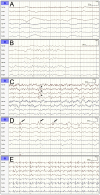The Role of Routine Electroencephalography in the Diagnosis of Seizures in Medical Intensive Care Units
- PMID: 38893637
- PMCID: PMC11171977
- DOI: 10.3390/diagnostics14111111
The Role of Routine Electroencephalography in the Diagnosis of Seizures in Medical Intensive Care Units
Abstract
Seizures should be diagnosed and treated to ensure optimal health outcomes in critically ill patients admitted in the medical intensive care unit (MICU). Continuous electroencephalography is still infrequently used in the MICU. We investigated the effectiveness of routine EEG (rEEG) in detecting seizures in the MICU. A total of 560 patients admitted to the MICU between October 2018 and March 2023 and who underwent rEEG were reviewed. Seizure-related rEEG constituted 47% of all rEEG studies. Totally, 39% of the patients experienced clinical seizures during hospitalization; among them, 48% experienced the seizure, and 13% experienced their first seizure after undergoing an rEEG study. Seventy-seven percent of the patients had unfavorable short-term outcomes. Patients with cardiovascular diseases were the most likely to have the suppression/burst suppression (SBS) EEG pattern and the highest mortality rate. The rhythmic and periodic patterns (RPPs) and electrographic seizure (ESz) EEG pattern were associated with seizures within 24 h after rEEG, which was also related to unfavorable outcomes. Significant predictors of death were age > 59 years, the male gender, the presence of cardiovascular disease, a Glasgow Coma Scale score ≤ 5, and the SBS EEG pattern, with a predictive performance of 0.737 for death. rEEG can help identify patients at higher risk of seizures. We recommend repeated rEEG in patients with ESz or RPP EEG patterns to enable a more effective monitoring of seizure activities.
Keywords: critical illness; intensive care unit; routine electroencephalography; seizure; unfavorable outcome.
Conflict of interest statement
The authors have no conflicts of interest to declare. The funders had no role in the design of the study; in the collection, analyses, or interpretation of data; in the writing of the manuscript; or in the decision to publish the results.
Figures



Similar articles
-
Continuous vs Routine Electroencephalogram in Critically Ill Adults With Altered Consciousness and No Recent Seizure: A Multicenter Randomized Clinical Trial.JAMA Neurol. 2020 Oct 1;77(10):1225-1232. doi: 10.1001/jamaneurol.2020.2264. JAMA Neurol. 2020. PMID: 32716479 Free PMC article. Clinical Trial.
-
Efficacy of delivery of care with Tele-continuous EEG in critically ill patients: a multicenter randomized controlled trial (Tele-cRCT study) study.Crit Care. 2025 Jan 7;29(1):15. doi: 10.1186/s13054-024-05246-x. Crit Care. 2025. PMID: 39773282 Free PMC article. Clinical Trial.
-
Diagnostic Accuracy of Ambulatory EEG vs Routine EEG in Patients With First Single Unprovoked Seizure.Neurol Clin Pract. 2023 Jun;13(3):e200160. doi: 10.1212/CPJ.0000000000200160. Epub 2023 May 8. Neurol Clin Pract. 2023. PMID: 37197370 Free PMC article.
-
Detection of electrographic seizures with continuous EEG monitoring in critically ill patients.Neurology. 2004 May 25;62(10):1743-8. doi: 10.1212/01.wnl.0000125184.88797.62. Neurology. 2004. PMID: 15159471 Review.
-
Continuous versus Routine Electroencephalography in the Intensive Care Unit: A Review of Current Evidence.Eur Neurol. 2024;87(1):17-25. doi: 10.1159/000535085. Epub 2023 Nov 10. Eur Neurol. 2024. PMID: 37952533 Free PMC article. Review.
References
-
- Panteliadis C.P. Historical overview of electroencephalography: From antiquity to the beginning of the 21st century. J. Brain Neurol. Disord. 2021;3:1–10. doi: 10.5281/zenodo.5359323. - DOI
Grants and funding
LinkOut - more resources
Full Text Sources

